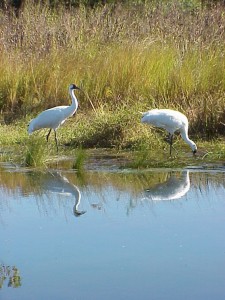by Chester McConnell, Editor
As editor of the Whooping Crane Conservation Association web page, I am concerned about several issues associated with the Aransas/Wood Buffalo whooping crane flock. These issues include the: (1) lack of information available to the public related to the apparent decline in the population of the cranes from 279 cranes in 2010-2011 to 245 cranes in 2011-2012; (2) the proposed new statistical sampling method to monitor the whooping crane population; and (3) the increasing difficulty to obtain information from government agencies that manage the flock.
I recognize that there have been several major changes in management personnel in both the U.S. Fish and Wildlife Service and Canadian Wildlife Service. Replacing long-term, experienced employees in complex programs normally results in some glitches. And then, the unusual weather and related food availability during the past year has seemingly caused migration abnormalities. I try to take these into consideration. Yet, when we cannot get any information on the whooping crane reproduction circumstances on Wood Buffalo habitats, I cannot fathom that. Good golly, the cranes are already beginning their migration south to Aransas National Wildlife Refuge, Texas and we have not heard a word about hatching success and related information during the past spring and summer. Why?
A major factor in the success of any program such as the whooping crane endangered species project is strong public support. Officials involved in the program today would be wise to review the history concerning how the Aransas/Wood Buffalo flock project evolved. In summary it was largely due to strong public pressure and long-term support from early U.S. and Canadian leaders in the Whooping Crane Conservation Association. We want to continue supporting the program but we need information from government project personnel to do so.
I visited the Aransas National Wildlife Refuge this week and discussed some of these issues with a couple of officials. The refuge is being managed well and the new observation tower is a tremendous improvement. They invited me to attend the U.S. Fish and Wildlife Service meeting in Fulton, Texas October 4, 2012 to participate in a briefing on crane survey methodology changes. Hopefully, we will at least get some answers and improved understanding about what is going on during this session. I urge you to attend.
UPDATE: The U.S. Fish and Wildlife Service just released (October 3, 2012) it’s report, Aransas-Wood Buffalo Whooping Crane Abundance Survey (2011-2012)”. We will be studying the report but have included it here so you, our viewers, will have the most current information.
The following news release provides details about the meeting.
News Release: Updates from The Aransas Project SEP 28, 2012
The Aransas Project (TAP) Members Urged to Attend Briefing on Crane Survey Methodology Changes
TAP members are urged to attend a critical public meeting being hosted by the Aransas National Wildlife Refuge to address the changes being made in the survey methods used to count the endangered whooping cranes that winter at the Refuge. Beginning in the winter of 2011-2012, U.S. Fish & Wildlife Service (USFWS) altered its methodology for tracking how many cranes are in the flock and this will be the first public meeting providing any insight or explanation of their methods. TAP members are strongly encouraged to attend to remain informed on this critical issue.
Thursday, October 4, 2012
6 PM to 8 PM
Paws and Taws Convention Center
402 North Fulton Beach Road, Fulton, TX 78358
According to a USFWS news release, the presentation “will investigate and define aerial survey methods used historically and currently to count the Aransas-Wood Buffalo flock of whooping cranes.” Refuge Biologist Brad Strobel will lead the presentation, and there will be a Q&A session following the presentation.
State of the Flock Report: TAP Concerns Persist
In July 2012, TAP released our State of the Flock 2011-2012 report, highlighting the following concerns:
• USFWS Methodology Faulted
Concerns regarding the new statistical sampling method used by USFWS, including reported concerns by former Refuge Biologist and Whooping Crane Recovery Coordinator Tom Stehn;
• Whooping Crane Flock Numbers Plunge during Winter 2011-2012
A stunning decline in the population of the cranes, even under USFWS’ statistical sampling method, from 279 cranes in 2010-2011 to 245 cranes in 2011-2012; and
• Tracking Data Suggests Unprecedented Crane Mortality
Evidence gathered from a smaller population of cranes tracked by GPS that suggests an unprecedented crane mortality of 9.6% in this monitored subgroup of birds that exceeds the previous high mortality rate of 8.5% experienced during the winter of 2008-2009.
USFWS Yet to Deliver Final Report
In their June 14, 2012 report, USFWS indicated they would issue a final “State of the Cranes” report by August 2012 summarizing the significant events that occurred during the 2011-12 whooping crane season. To date, USFWS has not released this annual state of the flock report.
TAP remains concerned about the absence of this report along with the changes in the survey methodology being used by USFWS to monitor the health of the Aransas-Wood Buffalo flock, and invites TAP members to come to the meeting to remain informed on this issue and ask questions of the Refuge staff.
USFWS Appoints New Crane Coordinator, Dr. Wade Harrell
In related news, USFWS recently issued a news release announcing the appointment of Dr. Wade Harrell as the new Whooping Crane Recovery Coordinator. According to the release, Wade will be part of the Region 2 Recovery staff in Albuquerque, but he will be based at Aransas National Wildlife Refuge. TAP welcomes Dr. Harrell in his important new role, and we hope that TAP members will have the opportunity to meet Dr. Harrell at the upcoming meeting.
We hope that you will join us.
Thanks so much for your continued support. Please feel free to forward this on to a friend.
Ron Outen
REGIONAL DIRECTOR, THE ARANSAS PROJECT



Pingback: Total Whooper Population Count Urged « Whooping Crane Conservation Association